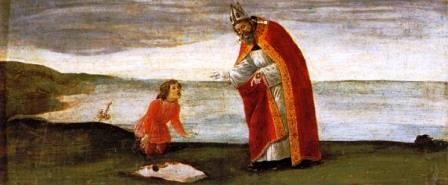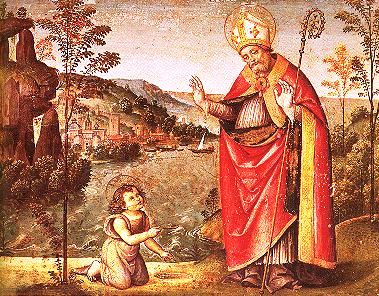I used an image in my entry about the Post Communion prayer for Mass of the Most Holy Trinity which drew comments in email.
The image, a painting by Botticelli, depicts the legendary meeting of St. Augustine with a boy along the seashore.

 The story goes like this, according to this version from the Golden Legend by Jacobus de Voragine (+1298) as translated by William Caxton (+1492).
The story goes like this, according to this version from the Golden Legend by Jacobus de Voragine (+1298) as translated by William Caxton (+1492).
Saint Augustine made a book of the Trinity, in which he studied and mused sore in his mind, so far forth that on a time as he went by the sea-side in Africa, studying on the Trinity, he found by the sea-side a little child which had made a little pit in the sand, and in his hand a little spoon. And with the spoon he took out water of the large sea and poured it into the pit.
And when Saint Augustine beheld him he marvelled, and demanded him what he did. And he answered and said: I will lade out and bring all this water of the sea into this pit. What? said he, it is impossible, how may it be done, sith the sea is so great and large, and thy pit and spoon so little? Yes, forsooth, said he, I shall lightlier and sooner draw all the water of the sea and bring it into this pit than thou shalt bring the mystery of the Trinity and his divinity into thy little understanding as to the regard thereof; for the mystery of the Trinity is greater and larger to the comparison of thy wit and brain than is this great sea unto this little pit. And therewith the child vanished away. Then here may every man take ensample that no man, and especially simple lettered men, ne unlearned, presume to intermit ne to muse on high things of the godhead, farther than we be informed by our faith, for our only faith shall suffice us.
This story has garnered many depictions in art. These are just a few.



































That is a great story. Makes me want to read more of the Golden Legend.
Such a sweet story (especially as the mother of a little boy). Our priest mentioned it in his homily today. Children can teach us so much.
Yeah, that is a good one. First time that I have ever seen it represented in art.
And for what it’s worth, I bet you could fit the Mediterranean Sea in a hole dug out of the beach if you were capable of deactivating the subatomic forces that hold protons and electrons apart so as to collapse all the atoms together and get rid of the wide empty space between ’em all.
Cobbler: But if we did that, could we be sure of where they were, or where we were?
As far as I know we could, though maybe there’d some quantum physics involved I and I haven’t heard about it — I would think before you got into uncertainty principle issues you’d get into the problem that the mass of the Mediterranean, when compressed into that small a space, would because of its density considerably influence the Earth’s center of gravity… Might be a decent way to break the planet up and end all life on it, for all I know (though if I were a real physicist, I could tell you how much it’d move the center of gravity; what remains after that is how much that would affect the tectonic plates and whatnot).
That should read “As far as I know we could, though maybe there’d be some quantum physics involved and I haven’t heard about it –”
Edit twice, post once. And get the glasses clean so you can actually see.
@The Cobbler
Well, sort of. If all the mass of the Mediterranean were packed down to nuclear density, it would still occupy a volume of about 9 cubic meters, which is about the volume of a cube 10 feet on a side. Such a hole would have already aroused surprise and suspicion in St. Augustine, and packed down to those densities the mass would certainly no longer be water.
@ContraMundum: Now the high school physics student in my brain is wondering what nuclear density for hydrogen and oxygen is or else what the mass of the mediterranean is so it could calculate the one from the other…
…meanwhile the employed, post-colleged-student part of my brain is justifying not looking it up on the grounds that I would find lots of other fascinating info along the way and be up all night, which wouldn’t go with that whole employment thing well.
(Although I’d love to know where you got the data, since the actual measurements involved to get the size of the hole is the one thing I’ve no clue where to find quickly and without tiptoeing around all sorts of other fun stuff along the way.)
All nuclei have pretty much the same density; even neutron stars are only a little more dense. It turns out that nuclear matter acts a lot like a liquid — in fact, in many ways like a superfluid liquid with zero viscosity. The density is determined by the strong nuclear force; this is the most important force, followed closely afterward by the electric repulsion between protons that makes large nuclei unstable.
I didn’t remember the density of nuclear matter or want to go to too much trouble to estimate the volume of the Mediterranean, so I just Googled both. I made a stupid mistake on the size of the hole, though; it would be about 7 ft, not 9 ft, on a side.
Aha, nice!
This story, and its meaning, particularly as it involves St. Augustine, lead the Holy Father to place a seashell on his papal coat of arms:
http://www.ewtn.com/vnews/getstory.asp?number=56178
Compressed matter, such that the atomic nuclei are squeezed together, is at the center of a Black Hole. Obviously Black Holes, having been formed from the collapse of a star, are (or would be) much more massive than a collapsed Mediterranean, but there would still be space-time deformation that is a consequence of the density. There would also be considerable effect on the matter nearby.
A visiting Comboni priest mentioned this in his homily at a OF Mass. Very beautiful story. St. Augustine, pray for us. +JMJ+
@rotbrown
OK, one last go at this, which I think is too far afield of the main point. What is at the center of a black hole is conjectural. The standard view is that it is a singularity, with all the mass being concentrated to a mathematical point of zero volume. Superstring theory says that it’s not exactly a singularity, but a very tight tangle of superstrings. The “size” of a black hole is otherwise given by the diameter of its event horizon; if the whole earth were compressed into a black hole, its event horizon would be about the size of a golf ball.
If the Mediterranean Sea were compressed to the density of nuclear matter, it would essentially be the nucleus of a very heavey atom, and it would be massively unstable. As it is, nuclei with atomic numbers greater than about 100 tend to have lifetimes that are a tiny fraction of a second; one or more “islands of stability” are theorized to exist for atomic numbers on the order of 130 or 140, but these have never been observed in nature or produced in the laboratory. The tendency of a neutron star to decay is counteracted by its intense gravity, but the gravity of a compressed Med Sea would not be enough to stop the decay. It would be a really big, really nasty bomb.
—-
All right. Having said all that, it has always struck me that quantum mechanics has the sort of style that makes sense from the Christian God. The Trinity is very hard to understand; it is like nothing in our everyday experience, and the concept produces seeming paradoxes. Quantum mechanics is very hard to understand; it is like nothing in our everyday experience, and the concept produces seeming paradoxes. Most good Christians at some point struggle to understand the Trinity at a deeper, more philosophical level, but eventually realize that this is beyond them and simply live with that and use the prayers the Church gives us; most good physicists at some point struggle to understand quantum mechanics at a deeper, more philosophical level, but eventually realize that this is beyond them and simply live with that and use the equations to make predictions. There’s something about this that is hard to define, yet distinctive, like what happens when you listen to a piece of music you’ve never heard before but immediately think, “This was written by Mozart.”